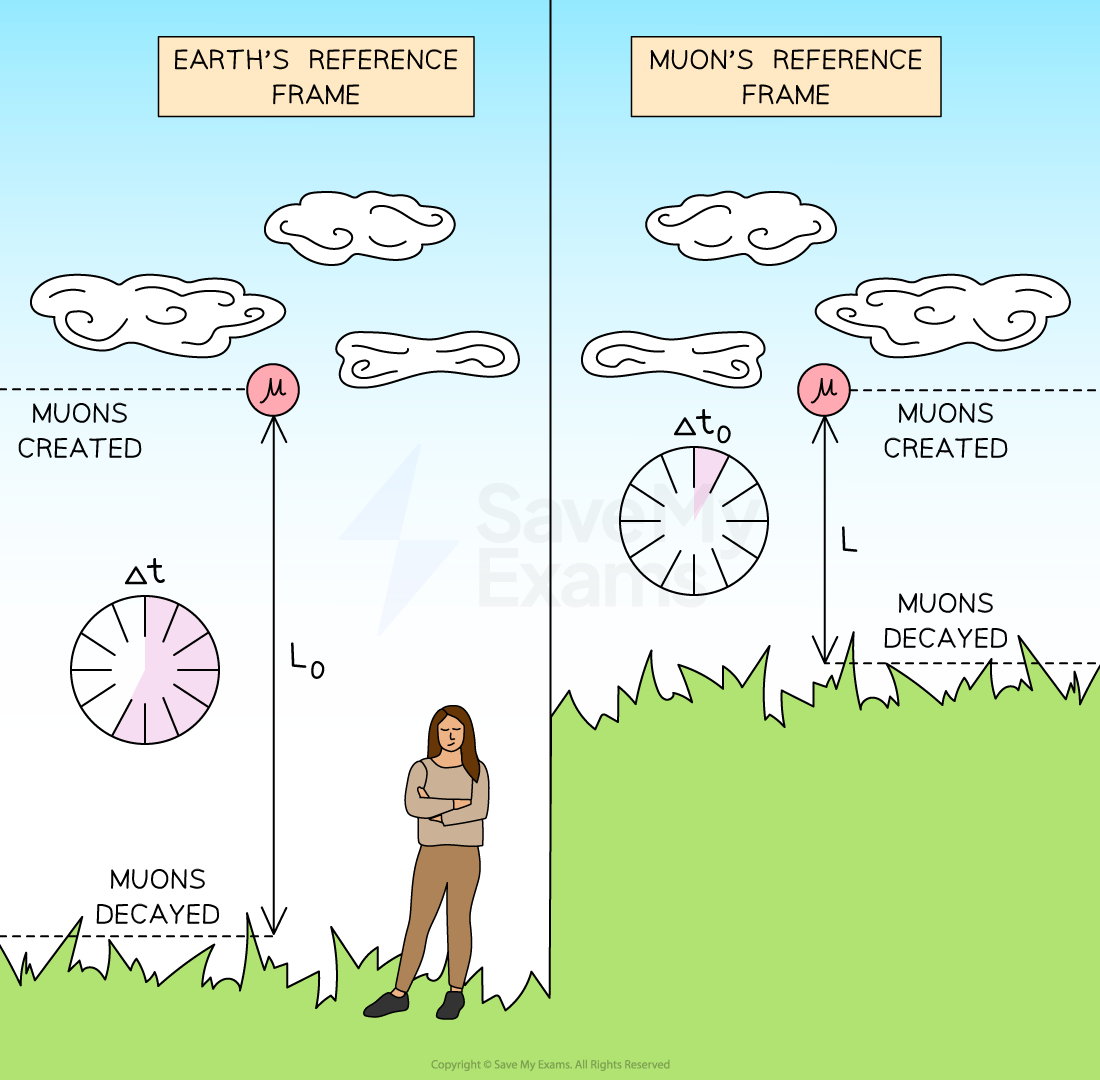Muon Lifetime Experiment (DP IB Physics): Revision Note
Muon Lifetime Experiment
Muon decay experiments provide experimental evidence for time dilation and length contraction
Muons are unstable, subatomic particles that are around 200 times heavier than an electron and are produced in the upper atmosphere as a result of pion decays produced by cosmic rays
Muons travel at 0.98c and have a half-life of 1.6 µs (or mean lifetime of 2.2 µs)
The distance they travel in one half-life is around 470 m
A considerable number of muons can be detected on the Earth's surface, which is about 10 km from the distance they are created
Therefore, according to Newtonian Physics, very few muons are expected to reach the surface as this is about 21 half-lives!
The detection of the muons is a product of time dilation (or length contraction, depending on the viewpoint of the observer)
Muon Decay From Time Dilation
According to the reference frame of an observer on Earth, time is dilated so the muon's half-life is longer
We can see this from the time dilation equation
Where:
The gamma factor,
= the half-life measured by an observer on Earth
= the proper time for the half-life measured in the muon's inertial frame
Therefore, in the reference frame of an observer on Earth, the muons have a lifetime of
The time to travel 10 km at 0.98c is 33 µs or 4.1 half-lives, so a significant number of muons remain undecayed at the surface
Muon Decay From Length Contraction
According to the muon's reference frame, length is contracted so the distance the need to travel is shorter
We can see this from the length contraction equation
Where:
= the proper length for the distance measured in the muon's inertial frame
= the distance measured by an observer on Earth
Therefore, in the reference frame of the muons, they only have to travel a distance:
To travel this distance takes a time of
= 6.8 µs which is about 4.3 half-lives again, so a significant number of muons remain undecayed at the surface

Muon decay from the Earth's and a muon's reference frame
Worked Example
Muons are created at a height of 4250 m above the Earth’s surface. The muons move vertically downward at a speed of 0.980c relative to the Earth’s surface. The gamma factor for this speed is 5.00. The half-life of a muon in its rest frame is 1.6 µs.
(a) Estimate the fraction of the original number of muons that will reach the Earth’s surface before decaying, from the Earth's frame of reference, according to:
(i) Newtonian mechanics
(ii) Special relativity
(b) Demonstrate how an observer moving with the same velocity as the muons, accounts for the answer to (a)(ii).
Answer:
(a) (i)
Step 1: List the known quantities
Height of muon creation above Earth's surface, h = 4250 m
Speed of muons, v = 0.980c
Lifetime of muon, t = 1.6 µs = 1.6 × 10–6 s
Step 2: Calculate the time to travel for the muon
Step 3: Calculate the number of half-lives
half-lives
Step 4: Calculate the fraction of the original muons that arrive
(a) (ii)
Step 1: List the known quantities
Time for the muon to travel,
= 1.45 × 10–5 s
Step 2: Calculate the time travelled in the muons rest frame
Step 3: Calculate the number of half-lives
half-lives
Step 4: Calculate the fraction of the original muons that arrive
(b)
Step 1: Analyse the situation
An observer moving with the same velocity as the muons will measure the distance to the surface to be shorter by a factor of
= 5 OR length contraction occurs
Step 2: Calculate the distance travelled in the muon's rest frame
Step 3: Calculate the time to travel
time taken =
Step 4: Calculate the number of half-lives
half-lives (same as (b))
Examiner Tips and Tricks
Remember that it is the observer on Earth that viewed the muons' lifetime or half-life as longer (time dilation), whilst it is the muons' reference frame that views the distance needed to travel as shorter (length contraction).
Always do a sense check with your answer, you must always end up with a longer time or shorter distance for the muons to be observed on the Earth's surface.
Any exam questions on this topic will only use the following equations:
Time dilation
Length contraction
Calculating half-lives through is a common way to calculate the number of muons remaining:
After 1 half-life,
the original muons remain
After 2 half-lives,
or
of the original muons remain
After 3 half-lives,
or
of the original muons remain, and so on

You've read 0 of your 5 free revision notes this week
Sign up now. It’s free!
Did this page help you?
